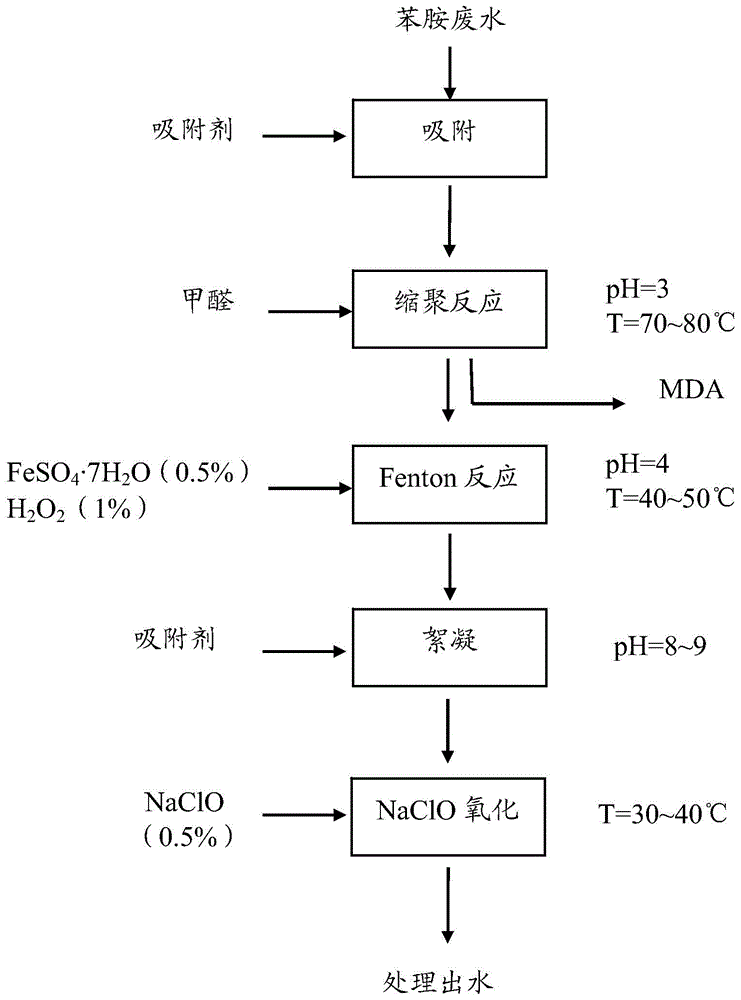Treatment method for aniline wastewater
A treatment method and technology for wastewater, applied in water/sewage multi-stage treatment, water/sludge/sewage treatment, chemical instruments and methods, etc., can solve the problem of increasing the salt content of wastewater, high one-time investment, and highly toxic intermediate products and other problems, to achieve the effect of improving the ability of oxidative degradation, simple process flow, easy and cheap medicine
- Summary
- Abstract
- Description
- Claims
- Application Information
AI Technical Summary
Problems solved by technology
Method used
Image
Examples
Embodiment 1
[0055] Add 1g / L activated carbon powder (based on the volume of the original wastewater) to aniline wastewater (original COD is 24800mg / L, aniline concentration is 8211mg / L) and stir for 0.5 hours to absorb, after filtration, clear liquid I is obtained; After adjusting the pH to 3 with hydrochloric acid and heating to 70°C, add 6g / L (based on the volume of the supernatant I) formaldehyde solution (the mass fraction of the formaldehyde solution is 37%), and keep stirring for 1 hour to adjust the pH to 7 Flocculation and filtration to obtain MDA and supernatant II. The quality of MDA is about 1% of the mass of serum Ⅰ, the purity of MDA is 96.8%, and the COD of serum Ⅱ is 1300 mg / L; the pH of serum Ⅱ is adjusted to 4, and the pH is adjusted to 8 after Fenton reaction for 1 hour Carry out flocculation, filter and obtain the COD of filtrate is 600mg / L, add the available chlorine of 0.3g / L in the filtrate (the volume of above supernatant liquid II is a basis, the available chlorine...
Embodiment 2
[0057] Add 1g / L activated carbon powder (based on the volume of the original wastewater) to aniline mixed wastewater (original COD is about 20000mg / L) and stir for 0.5 hours to absorb, and obtain clear liquid I after filtration; the pH of clear liquid I is adjusted with concentrated hydrochloric acid to 3 and heated to 70°C, add 4g / L (based on the volume of the supernatant I) formaldehyde solution (the mass fraction of the formaldehyde solution is 37%), keep stirring and react for 1 hour, adjust the pH to 7 by flocculation filtration, and obtain Solid and supernatant II, the solid product accounted for 0.75% of the mass of the supernatant I was detected as a recoverable compound, and the COD of the supernatant was 2010 mg / L; the pH of the supernatant II was adjusted to 4, and Fenton reacted for 1 hour Afterwards, the pH is adjusted to 8 for flocculation and activated carbon powder is added to stir and decolorize, and the filtrate is filtered to obtain the filtrate. The availab...
Embodiment 3
[0059] Add 1g / L diatomaceous earth (based on the original wastewater volume) to aniline mixed wastewater (original COD is about 20000mg / L) and stir for 0.1 hour to absorb, and obtain clear liquid I after filtration; adjust pH of clear liquid I with concentrated hydrochloric acid After heating to 5 and heating to 80°C, add 4g / L (based on the volume of the supernatant I) formaldehyde solution (the mass fraction of the formaldehyde solution is 37%), keep stirring and react for 1 hour, then adjust the pH to 8 for flocculation filtration, The solid and supernatant II were obtained. The solid product accounted for 0.60% of the mass of the supernatant I. It was detected that it was a recoverable compound. The COD of the supernatant was 4709 mg / L; the pH of the supernatant II was adjusted to 4, and Fenton reacted for 1 hour Afterwards, the pH is adjusted to 8 for flocculation, and the filtrate obtained by filtration is transparent and slightly yellow, and the COD is 1060mg / L, and the a...
PUM
 Login to view more
Login to view more Abstract
Description
Claims
Application Information
 Login to view more
Login to view more - R&D Engineer
- R&D Manager
- IP Professional
- Industry Leading Data Capabilities
- Powerful AI technology
- Patent DNA Extraction
Browse by: Latest US Patents, China's latest patents, Technical Efficacy Thesaurus, Application Domain, Technology Topic.
© 2024 PatSnap. All rights reserved.Legal|Privacy policy|Modern Slavery Act Transparency Statement|Sitemap

